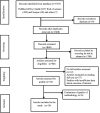Incidence and predictors of postoperative complications in Sub-Saharan Africa: a systematic review and meta-analysis
- PMID: 38784705
- PMCID: PMC11112115
- DOI: 10.3389/frhs.2024.1353788
Incidence and predictors of postoperative complications in Sub-Saharan Africa: a systematic review and meta-analysis
Abstract
Background: Postoperative complications remain a significant challenge, especially in settings where healthcare access and infrastructure disparities exacerbate. This systematic review and meta-analysis aimed to determine the pooled incidence and risk factors of postoperative complications among patients undergoing essential surgery in Sub-Saharan Africa (SSA).
Method: PubMed/MEDLINE, EMBASE, CINAHL, Web of Science, and Google Scholar were searched from January 2010 to November 2022 for completed studies reporting the incidence and risk factors associated with postoperative complications among patients undergoing essential surgery in SSA. Severity of postoperative complications was ranked based on the Clavien-Dindo classification system, while risk factors were classified into three groups based on the Donabedian structure-process-outcome quality evaluation framework. Studies quality was appraised using the JBI Meta-Analysis of Statistics Assessment and Review Instrument (JBI-MAStARI), and data were analyzed using Comprehensive Meta-Analysis (CMA) software. The study protocol adhered to the PRISMA guidelines and was registered in PROSPERO (CRD42023414342).
Results: The meta-analysis included 19 studies (10 cohort and 9 cross-sectional) comprising a total of 24,136 patients. The pooled incidence of postoperative complications in SSA was 20.2% (95% CI: 18.7%-21.8%), with a substantial heterogeneity of incidence observed. The incidence varied from 14.6% to 27.5% based on the Clavien-Dindo classification. The random-effects model indicated significant heterogeneity among the studies (Q = 54.202, I = 66.791%, p < 0.001). Contributing factors to postoperative complications were: structure-related factors, which included the availability and accessibility of resources, as well as the quality of both the surgical facility and the hospital.; process-related factors, which encompassed surgical skills, adherence to protocols, evidence-based practices, and the quality of postoperative care; and patient outcome-related factors such as age, comorbidities, alcohol use, and overall patient health status.
Conclusion: The meta-analysis reveals a high frequency of postoperative complications in SSA, with noticeable discrepancies among the studies. The analysis highlights a range of factors, encompassing structural, procedural, and patient outcome-related aspects, that contribute to these complications. The findings underscore the necessity for targeted interventions aimed at reducing complications and improving the overall quality of surgical care in the region.
Systematic reviews registration: https://www.crd.york.ac.uk/PROSPERO/, identifier (CRD42023414342).
Keywords: Sub-Saharan Africa; essential surgery; meta-analysis; postoperative complications; quality measure.
© 2024 Yadeta, Manyazewal, Demessie and Kleive.
Conflict of interest statement
The authors declare that the research was conducted in the absence of any commercial or financial relationships that could be construed as a potential conflict of interest.
Figures




Similar articles
-
Adherence to evidence-based implementation of antimicrobial treatment guidelines among prescribers in sub-Saharan Africa: a systematic review and meta-analysis.J Pharm Policy Pract. 2023 Nov 7;16(1):137. doi: 10.1186/s40545-023-00634-0. J Pharm Policy Pract. 2023. PMID: 37936215 Free PMC article. Review.
-
Prevalence of tuberculosis among prisoners in sub-Saharan Africa: a systematic review and meta-analysis.Front Public Health. 2023 Dec 28;11:1235180. doi: 10.3389/fpubh.2023.1235180. eCollection 2023. Front Public Health. 2023. PMID: 38222088 Free PMC article.
-
Health-related quality of life and associated factors among epilepsy patients in sub-Saharan Africa: a systematic review and meta-analysis.Front Neurol. 2025 Mar 5;16:1546911. doi: 10.3389/fneur.2025.1546911. eCollection 2025. Front Neurol. 2025. PMID: 40109845 Free PMC article.
-
Healthcare providers' knowledge, attitude, and practice towards cervical cancer screening in Sub-Saharan Africa: systematic review and meta-analysis.Front Oncol. 2024 Aug 19;14:1436095. doi: 10.3389/fonc.2024.1436095. eCollection 2024. Front Oncol. 2024. PMID: 39224813 Free PMC article.
-
Survival pattern of colorectal cancer in Sub-Saharan Africa: A systematic review and meta-analysis.Cancer Epidemiol. 2022 Dec;81:102276. doi: 10.1016/j.canep.2022.102276. Epub 2022 Oct 17. Cancer Epidemiol. 2022. PMID: 36257176 Review.
Cited by
-
Surgical Management of an Intracranial Injury Caused by a Handcrafted Arrow in Sub-Saharan Africa: A Global Neurosurgical Relevance.Cureus. 2025 Jun 19;17(6):e86374. doi: 10.7759/cureus.86374. eCollection 2025 Jun. Cureus. 2025. PMID: 40688921 Free PMC article.
References
-
- Price R, Makasa E, Hollands M. World health assembly resolution WHA68.15: “strengthening emergency and essential surgical care and anesthesia as a component of universal health coverage”—addressing the public health gaps arising from lack of safe, affordable and accessible surgical and anesthetic services. World J Surg. Springer New York LLC. (2015) 39(9):2115–25. 10.1007/S00268-015-3153-Y/METRICS - DOI - PubMed
Publication types
LinkOut - more resources
Full Text Sources
Research Materials

